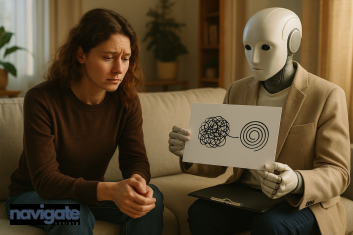Demystifying CBT: Why the Diagnostic Interview Sets the Stage for Healing (Part 2 of the CBT Gold Standard series)
Posted on: Apr 07, 2025
When beginning Cognitive Behavioural Therapy (CBT) for anxiety, it can be tempting to want to jump straight into tools and techniques. But CBT isn’t a one-size-fits-all process. That’s why the initial evaluation and diagnostic interview is not just a formality—it is the essential first step that personalises treatment, builds trust, and ensures the therapy is grounded in your unique story.
The Interview with Purpose
In CBT, the diagnostic interview is designed to gather key insights into how anxiety operates in your life. Unlike a casual conversation, this structured session is based on scientific frameworks like the DSM-5 diagnostic criteria, which helps ensure that clinicians identify the correct disorder(s) and subtypes. For example, the presentation of social anxiety may look very different from generalised anxiety disorder (GAD), and both demand different therapeutic strategies.
This phase often involves exploring:
- What situations trigger your anxiety most often
- What you typically do in response (avoidance, safety behaviours, reassurance seeking)
- The physical sensations you experience
- The thoughts that accompany or amplify the anxiety
- Your goals, values, and previous coping strategies
This information helps the therapist formulate a cognitive-behavioural model tailored to your experience.
Data That Informs Direction
Alongside the clinical interview, many CBT clinicians use brief but powerful questionnaires to deepen their understanding. These assessments are not meant to label, but to map the terrain:
- How intense is your anxiety?
- Is your anxiety generalised or situational?
- Are there signs of coexisting issues like depression or panic attacks?
This data doesn’t just sit in a file. It becomes the roadmap for choosing interventions like exposure tasks, thought records, or behavioural experiments.
Building a Therapeutic Partnership
CBT is collaborative at its core. The initial interview is also an opportunity for you to evaluate the therapist. Do you feel safe? Heard? Understood? Studies show that the strength of the therapeutic alliance—the sense of mutual respect and shared goals between therapist and client—is one of the best predictors of success in therapy.
In a good CBT setting, you are not a passive patient. You are an active participant. The diagnostic phase empowers you with self-awareness, helps you set goals, and invites you into the therapeutic process with agency.
Setting Expectations and Structure
CBT thrives on structure. The initial sessions clarify what CBT will look like:
- Weekly sessions, often 12-20 weeks
- Homework between sessions
- Practical tools and skills (not just talking)
- A focus on current patterns rather than deep dives into childhood (unless relevant)
Knowing what to expect reduces uncertainty and builds hope. For people already dealing with anxiety, that clarity can be grounding.
Conclusion: The Power of Understanding Before Action
The initial diagnostic interview in CBT is not about labelling or boxing you in. It’s about creating a clear, compassionate understanding of your challenges so that every technique, tool, and insight is relevant to you. It builds the bridge from distress to progress. Whether you’re starting CBT for yourself or supporting a loved one, understanding the purpose and power of this first step can turn apprehension into confidence and fear into focused healing.




